
Lavateras, shrubby and annual: planting, sowing, pruning and care
Contents
Lavatera in a nutshell
- Mallow forms, in one season, very lovely flowering bushes
- All summer and until the first frosts, the bush is covered in large satin-like flowers resembling hibiscus flowers
- Hardy down to -10°C, -12°C, it is best suited for mild climates
- It grows in full sun in dry, well-drained soil
- It is a must-have for flowering hedges, perennial or annual beds, and flowering pots
A word from our expert
Star of yesteryear gardens, the Lavatera quickly forms charming flowering bushes that are essential in cottage gardens, coastal gardens, as well as in mixed borders and romantic flower beds.
From the shrubby perennial Lavatera ‘Barnsley’ to the maritime Lavatera and the annual Lavatera, all are highly floriferous from June to October.
With their numerous silky flowers with five satin petals similar to those of Hibiscus and their downy leaves, they radiate in the sun and are easy to combine with perennial, annual, or bush flower beds. While most Lavateras declinate all shades of pink and mauve, there are some varieties of white Lavatera such as the annual Lavatera ‘White Regis’.
Easy to plant or sow, with a fast and generous growth, it is ideal for beginner gardeners. It is a full sun plant that adapts to any soil, even ordinary, dry, and well-drained.
Very bright, it will bring colour and poetry to your borders, free hedges, centrepieces, and even your pots.
How to sow Lavatera seeds, how to prune the shrub Lavatera, discover all our tips and choose from our unique collection of Lavateras the one that is missing from your garden!
Description and Botany
Botanical data
- Latin name Lavatera
- Family Malvaceae
- Common name Lavatère, Tree Mallow
- Flowering October to November
- Height 0.60 to 2 m
- Exposure Sun, partial shade
- Soil type All, well-drained
- Hardiness -10°C to -15°C
La Lavatère appartient à la famille des Malvacées comme les althéas, les mauves ou les hibiscus avec lesquels on la confond souvent. Le genre Lavatera regroupe environ 25 espèces d’arbustes, d’annuelles ou de vivaces poussant spontanément dans les zones rocheuses sèches, les sols plutôt pauvres et calcaires des régions tempérées principalement sur le pourtour méditerranéen.
On distingue la lavatère arbustive ou Mauve arbustive au port arbustif qui est une vivace semi-persistante ou persistante de la lavatère annuelle ou mauve annuelle à l’instar de la Lavatera trimestris et de ses cultivars (‘Loveliness’, ‘Ruby Regis’)
Du côté des lavatères arbustives ou Lavatères en arbre, on rencontre le plus souvent dans nos jardins, la Lavatera olbia, la lavatère maritime, une espèce protégée et les formes hybrides (L. x hybridum) comme Lavatera x clementii avec les cultivars incontournables comme ‘Barnsley’, ‘Burgundy Wine’. La plupart sont aujourd’hui nommées directement par leur nom de cultivar (‘Candy Floss’).
Sa croissance très rapide (plus de 2 m de haut en quelques mois pour la lavatère arbustive) n’a d’égal que sa courte durée de vie (4 à 6 ans en sol riche et frais contre 6 à 8 ans en sol drainant et pauvre).
La lavatère forme de belles touffes buissonnantes équilibrées et ramifiées au port évasé. Plus ou moins haute selon les variétés, elle atteint rapidement de 0,60 à 3 m de hauteur pour presqu’autant d’envergure. Sa base ligneuse produit chaque année de longues pousses. La Lavatère annuelle a une forte propension à se ressemer facilement d’une année sur l’autre.

Lavatera trimestris – botanical illustration
De grandes tiges duveteuses partant de la souche, portent des feuilles alternes, longuement pétiolées de 3 à 20 cm de long. Arrondies, elles sont souvent palmées, rappelant la feuille d’érable, découpées en 3 à 7 lobes peu marqués dont la base est parfois en forme de cœur. Légèrement duveteuses, elles sont vert moyen ou d’un remarquable gris cendré et persisteront durant l’hiver en climat doux et en bord de mer.
La lavatère se distingue par l’abondance et l’éclat de sa floraison rappelant la délicatesse de celle des hibiscus et des mauves. De juin-juillet à octobre (plus tôt en climat chaud), elle produit inlassablement des fleurs solitaires ou en grappes à l’aisselle des feuilles étagées sur la partie haute des tiges.
Les fleurs en entonnoir (‘Burgundy Wine’) ou en coupe simples, de 3 à 10 cm de diamètre sont composées de 5 pétales satinés parfois assez écartés et fortement bilobés comme chez les variétés ‘White Angel’ et ‘Sweet Dreams’. Toutes s’épanouissent en larges corolles très évasées.
Elles prennent des teintes très nuancées selon les variétés : rose tendre, rose pourpré, rose foncé, rouge carmin ou blanc pur, elles sont parfois bicolores d’un rose très pâle maculé de violet-pourpre (Lavatera maritima) ou subtilement veinées de plus sombre.
Avec leur coloris pastel, elles forment de beaux bouquets éphémères.
Non parfumées, elles compensent largement ce manque de parfum par leur remarquable floribondité, se renouvelant jusqu’aux premières gelées et attirant particulièrement les abeilles, les papillons et autres insectes pollinisateurs.
Après floraison, les fleurs se muent en capsules noires contenant de grosses graines faciles à ressemer chez les lavatères annuels.
La lavatère arbustive aime le plein soleil et les emplacements chauds et abrités des vents froids et desséchants. Assez frugale, préférant les sols secs, légers, ordinaires à tendance calcaire, elle est armée contre la sécheresse et le vent salé. Semi-rustique, en terrain bien drainé, elle résistera jusqu’à -10 ou -15 °C, sa préférence allant au climat doux du bord de mer. Les lavatères annuelles sont plus tolérantes vis-à-vis du sol.
Les lavatères s’utilisent en isolé ou groupées pour fleurir les massifs de vivaces ou d’annuelles, mixed-border, haies libres ainsi qu’en bac sur une terrasse ou un balcon.

Flowers of lavatères: Lavatera ‘Burgundy Wine’ (photo Magnus Manske), Lavatera ‘Brushing Bride’ and ‘Candy Floss’, Lavatera maritima ‘Bicolor’
Main species and varieties
In the genus Lavatera, we distinguish between the bush mallow with a bushy habit and the annual mallow, which is smaller and has a lifespan of no more than one year.
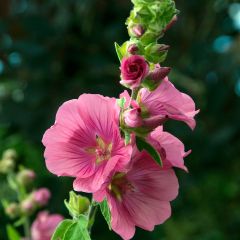
Lavatera Burgundy Wine - Tree Mallow
- Flowering time July to November
- Height at maturity 1,50 m
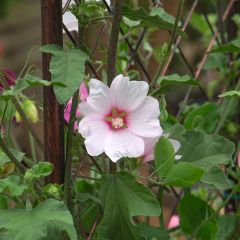
Lavatera clementii Barnsley - Tree Mallow
- Flowering time July to November
- Height at maturity 1,50 m
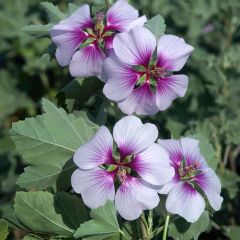
Lavatera maritima Bicolour - Tree Mallow
- Flowering time July to November
- Height at maturity 1,20 m
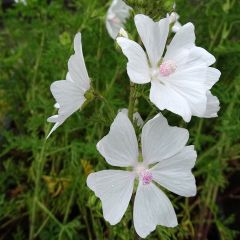
Lavatera White Angel - Tree Mallow
- Flowering time July to October
- Height at maturity 1,50 m
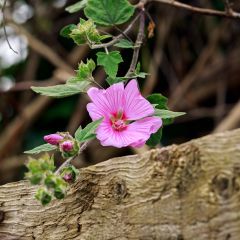
Lavatera Candy Floss - Tree Mallow
- Flowering time July to November
- Height at maturity 1,50 m
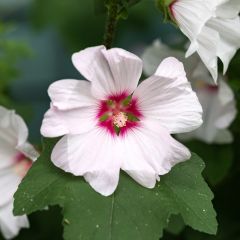
Lavatera Blushing Bride - Tree Mallow
- Flowering time July to November
- Height at maturity 1,50 m

Collection of Lavateras
- Flowering time July to November
- Height at maturity 1,50 m
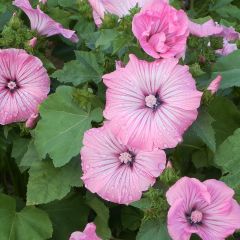
Lavatera trimestris Silver Cup - Rose Mallow seeds
- Flowering time August to October
- Height at maturity 50 cm

Lavatera trimestris Loveliness - Annual Mallow Seeds
- Flowering time August to November
- Height at maturity 1 m
Discover other Lavatera - Tree Mallow
View all →Available in 2 sizes
Available in 0 sizes
Available in 2 sizes
Available in 1 sizes
Available in 1 sizes
Available in 1 sizes
Available in 1 sizes
Available in 1 sizes
Available in 1 sizes
Available in 1 sizes
Planting
Where to plant Bush and Annual Lavateras?
The Tree Mallow is a Mediterranean bush that grows on its own in dry and mild climates. It does not tolerate overly humid regions well, but its foliage withstands the sea spray of coastal areas. Easy to grow, it withstands bad weather well.
Provide it with sunlight (in the south, it will tolerate partial shade) and a spot that is well sheltered from strong, drying winds and the severe cold of winter. Therefore, prefer a south-facing or west-facing planting. Its hardiness is average. In well-drained soil, it can withstand frost down to -10 or -15 °C. Occasionally, frost may halt growth in the ground; as long as it does not experience severe frosts, the plant will regrow from the roots. In harsh climates, protect it with a good mulch to help it survive the winter.
The Bush Mallow prefers light, deep, slightly dry, ordinary soils with a tendency towards lime and very well-drained conditions, where it will be more long-lived (6 to 8 years compared to 4 to 6 years in heavy soil) because it fears stagnant moisture in clay soils that can suffocate it.
Annual lavateras, on the other hand, are frost-sensitive plants that will disappear with the first frosts. They are more tolerant compared to perennial species and will accept growing even in heavy, rich, and cool soil. However, overly rich soil will promote foliage growth at the expense of flowering.
Lavatera can be used as a solitary plant or in groups. Not very bulky, it will not hinder its neighbouring plants and will become in just a few months a graceful bush of considerable size and very floriferous.
Do ensure a well-cleared location as each young lavatera will quickly occupy 1m² in the first year, doubling in size the following year.
Essential in cottage gardens and naturalistic gardens, Lavatera is also a good plant to flower a brand new garden or a holiday garden; growing very quickly, it makes a significant impact very quickly and allows for the rapid concealment of an unsightly view or dressing up a bare space.
The Bush Mallow is versatile and with its always fresh colours, it stands out in borders, free hedges, and mass plantings. In regions with harsh winters, growing in large pots is preferable. Annual lavateras will adorn borders, slopes, and flowering pots.
When to plant Bush Lavateras or Tree Mallow?
The planting of Bush Lavateras takes place after the last frosts, from February to May in the north of the Loire and from August to October in mild climates.
How to plant the Bush Mallow or Tree Mallow?
In the ground
This bush prefers light and well-drained soils. If your soil is heavy, add river sand and 50% potting soil. Trim the branches by a third to facilitate recovery.
- Prepare the soil to a depth of half a spade
- Dig a hole 2 to 3 times the volume of the pot
- Make a gravel bed at the bottom of the hole
- Plant the bush at collar level
- Fill the hole while keeping the bush upright, with the extracted soil mixed with a draining mixture
- Lightly compact with your foot
- Mulch the base to retain moisture
- Water generously at planting
In a pot
The substrate must be very draining: the soil should remain cool, but without stagnant water. Place it in full sun in a large terracotta pot of at least 50 cm in diameter. Opt for a modest-sized bush mallow ‘Barnsley Baby’.
- Spread a good layer of drainage (gravel or clay balls)
- Plant in a mixture of soil and rose potting soil in equal parts
- Mulch the base
- Water abundantly, allowing the substrate to dry out between waterings
- In summer, water as soon as the soil is dry on the surface
- Bring the pot indoors to protect it from frost in cold regions and reduce watering
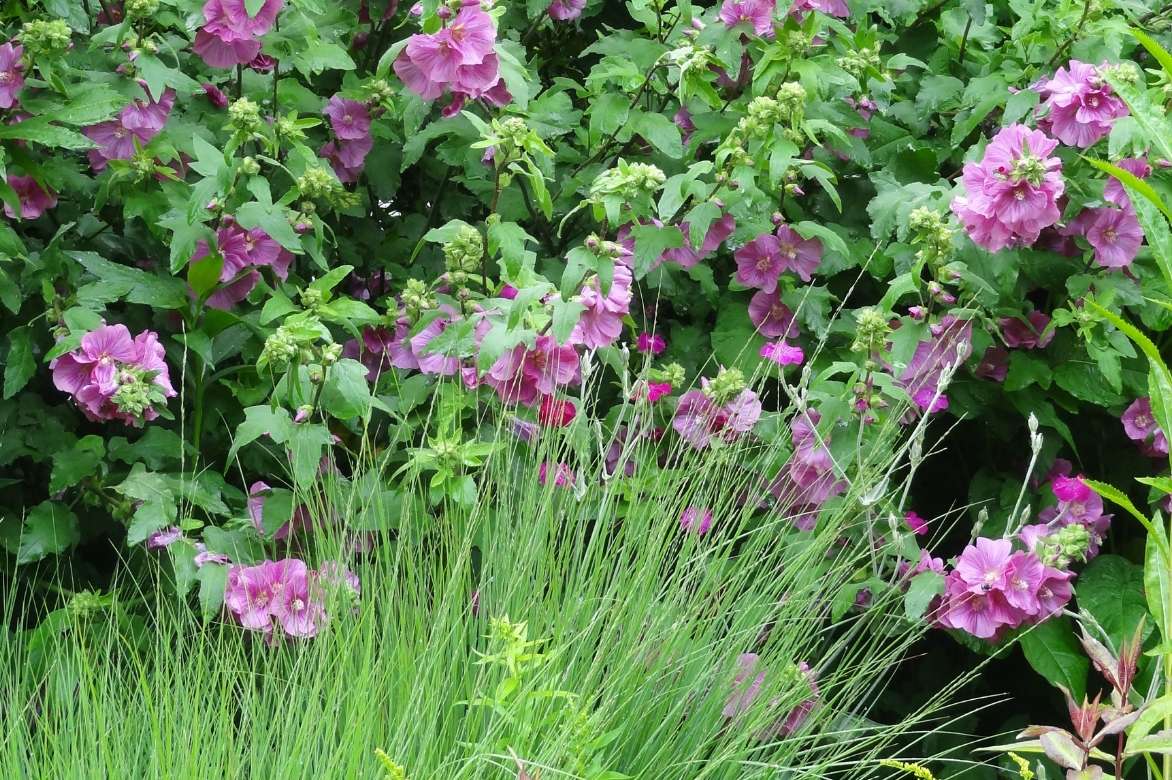
Lavateras pair very well with grasses
When and how to sow annual lavatera seeds?
Annual mallow seeds or lavatera seeds are sown in March, in a warm sheltered place or in spring, directly in open ground in the sun, when temperatures warm up and the last frosts are no longer a concern. One packet of lavatera seeds can flower several beds. Plant about 5 annual lavatera seedlings per m².
Sowing annual lavatera seeds under cover from March
- Sow at a temperature of 15-20 °C, 3 seeds per bucket in well-draining potting soil
- Cover with a thin layer of potting soil
- Firm down and water
- Place the seedlings in a warm spot and keep moist until germination
- Keep only one plant per bucket
- Transplant the plants into open ground or pots from May when the soil is well warmed
- Water regularly, the soil should remain moist
Sow annual lavatera seeds directly in the ground from April/May
- Sow in clusters of 3 or 5 seeds
- Cover the seeds with a layer of seed compost
- Firm down
- Water regularly and lightly to aid germination
- Thin out to keep only one vigorous plant every 40 cm
- When the seedlings are about 20 cm tall, pinch the main stems to encourage branching
Maintenance, pruning and care
The Tree Mallow is easy to maintain and when well established in perfectly drained soil, it offers better hardiness and greater resistance to the passage of time.
In winter, protect your bush with a thick mulch of dead leaves or dry ferns to insulate its roots from the cold as much as possible. In summer, mulch around the base to retain moisture.
Water regularly but without excess during the first summer following planting. Afterwards, being perfectly adapted to sun and drought, it will withstand a temporary dry spell well: its flowering will last longer if the soil remains cool.
The potted Tree Mallow requires more frequent watering in summer; water every 3 to 4 days. Also, provide it with a few handfuls of well-rotted compost at the beginning of spring. In summer, regularly remove faded flowers to encourage further blooming.
With an average lifespan of 5 to 6 years, consider renewing one plant out of three each year to maintain beautiful compositions in borders or hedges.
In autumn, pull out the deflowered annual mallows while removing as many roots as possible.
When and how to prune the Tree Mallow
The Tree Mallow has a short lifespan. Pruning, especially of large branches, helps maintain generous flowering, stimulates growth by encouraging the development of new flowering shoots, and extends the plant’s lifespan.
To ensure abundant flowering, it is advisable to prune tree mallows severely in spring in March, as soon as the buds swell.
- Cut back to a few centimetres above the ground, leaving only two or three buds at the base of this year’s shoots
- Remove excess or poorly placed old wood
During summer, you can lightly prune by cutting back the deflowered branches
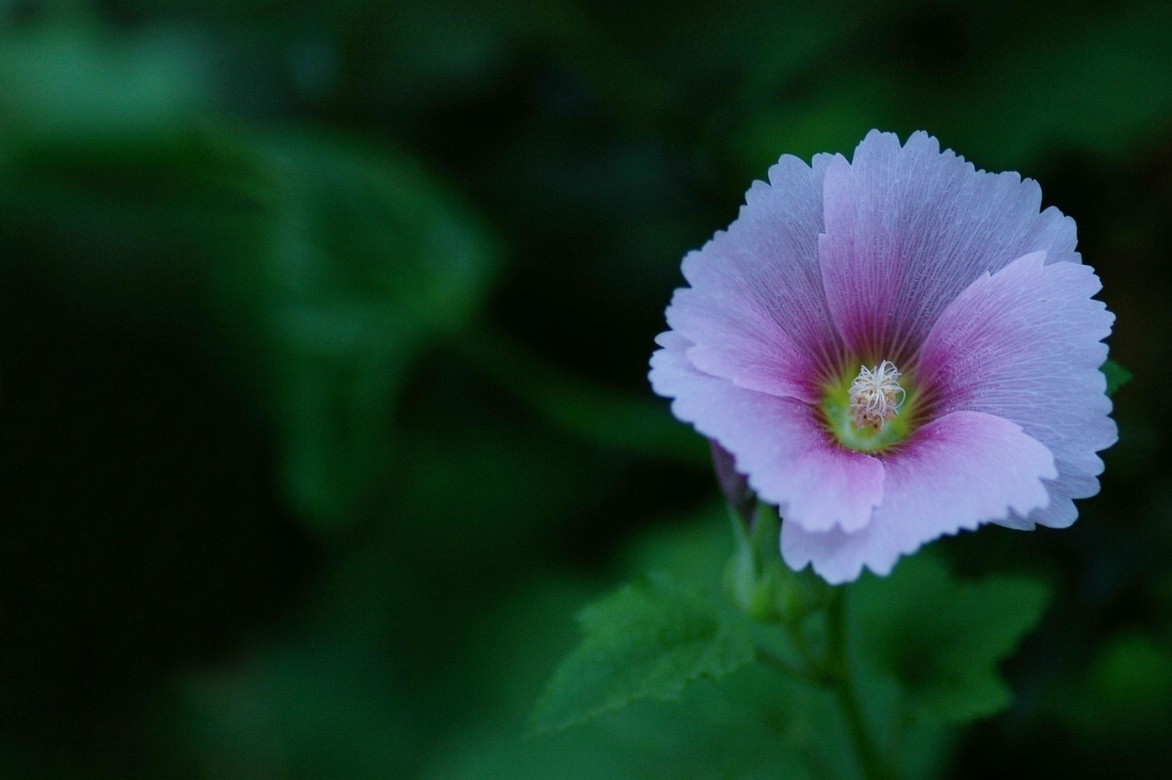
Lavatera trimestris
Diseases and potential pests
Rather robust, the lavatera fears only two things: cold and humidity.
In an overly humid environment, it can be prone to rust, which causes orange-brown spots and pustules that are not particularly harmful to the plant but are unsightly on the leaves.
Cut and burn the affected leaves and reduce watering: avoid wetting the foliage, favour watering at the base. As a preventive measure, spray with pure wormwood manure.
In overly heavy soil, it will be sensitive to stump rot and fungal infections.
Propagating
Multiply your lavateras without hesitation as the shrub species have a relatively short lifespan! This is the only way to perpetuate your plants. The quickest and simplest technique is propagation by cuttings from July to August.
- At the end of summer, take semi-ripe cuttings about 10 cm long from non-flowering stems
- Insert them into a mixture of sand and turf kept very slightly moist
- Place under a frame
- After 2 months, transplant the cuttings into individual buckets in a sandy mixture
- Overwinter in a frost-free environment
- Transplant into the ground in the following spring or autumn
Associating
Lavateras are essential in a dry naturalist garden, in a cottage garden, and of course in a pink garden where they add density and brightness to romantic flower beds, free hedges, borders, and rockeries.
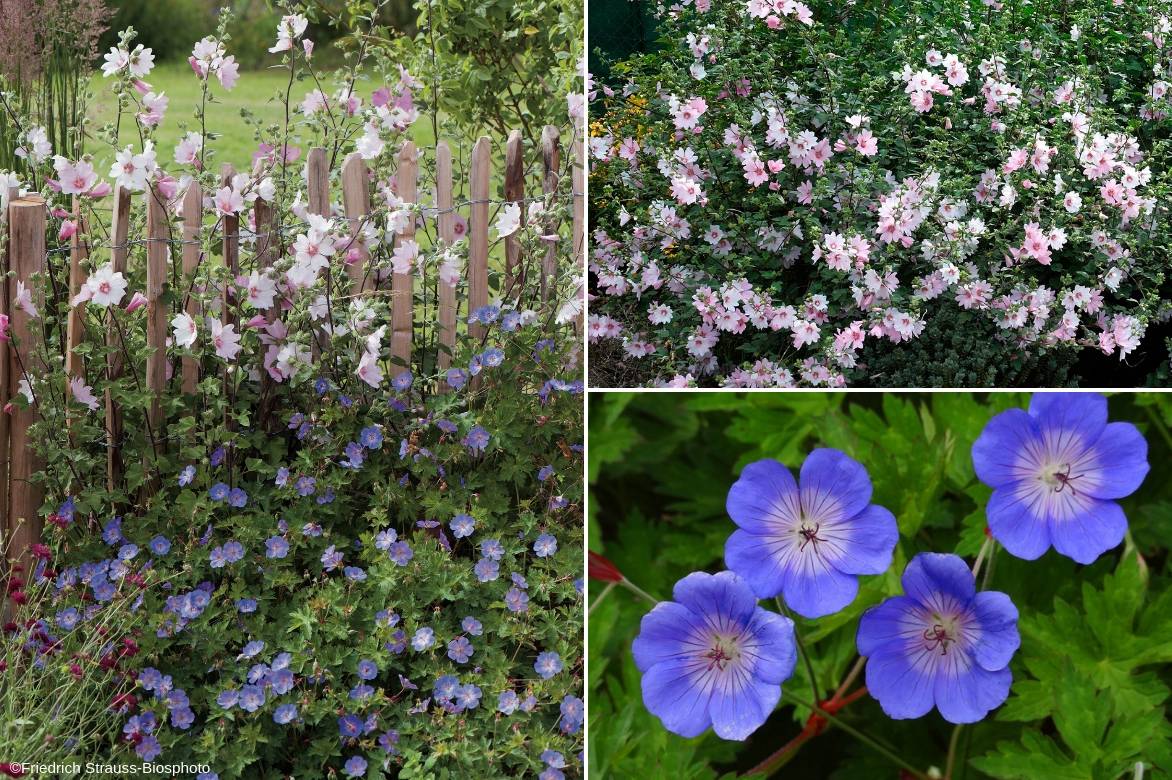
An example of a romantic pairing: Lavatera ‘Barnsley’, Geranium ‘Rozanne’
Whether they are bushy or annual lavateras, they are perfect for flowering in isolated bushes or groups, a young garden or a holiday garden with low maintenance alongside other bushes or summer-flowering perennials that love the sun. They are easy to pair with many perennials in cool colour combinations and with purple, silver, or glaucous foliage.
In a flowering bed that is light and harmonious in tone, pair them with perennial flax, large pink and purple asters, nepetas, or gauras, campanulas, eupatoriums, and lavenders.
In a stunning flowering border from mid-summer to the first frosts, combine a large clump of bushy lavatera with Japanese anemones, chrysanthemums, and large sedums and hardy geraniums to edge the whole.
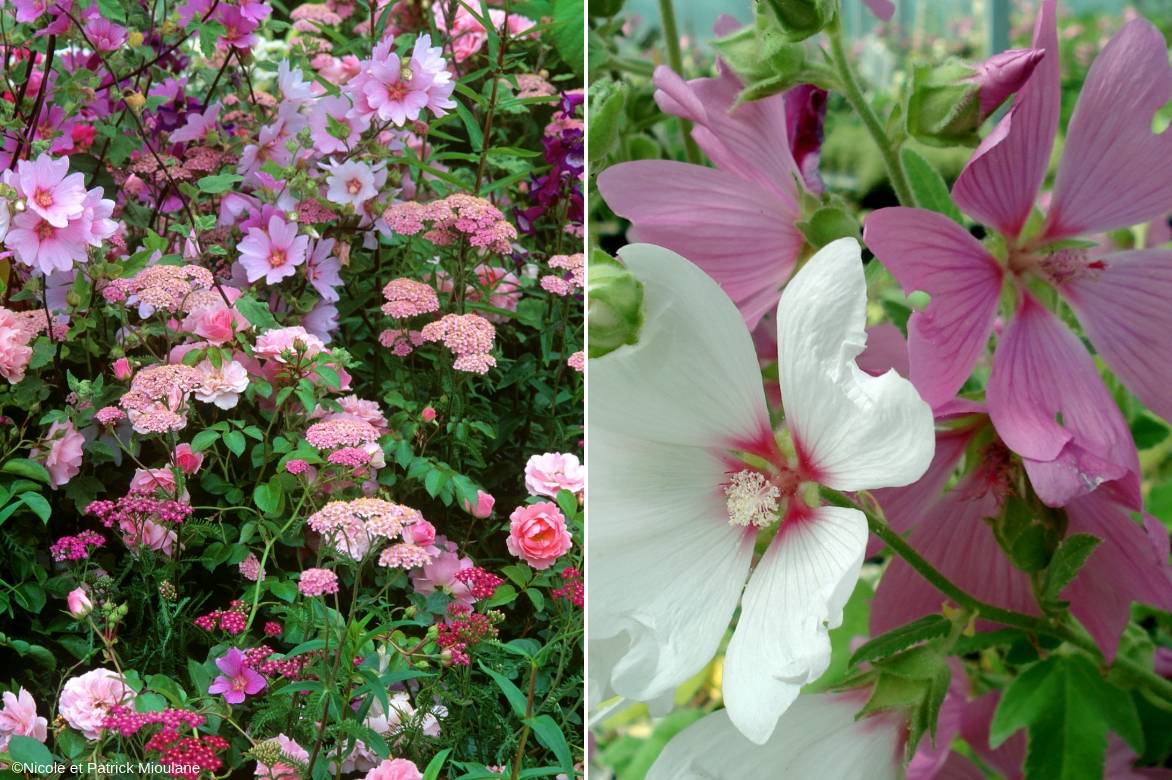
An example of an opulent pairing: Lavateras like Lavatera ‘Candy Floss’ and ‘Blushing Bride’, Achillea ‘Apfelblut’ and ‘Cerise Queen’, Penstemon like ‘Purple Passion’ and English roses
Its somewhat untidy habit will benefit from being paired with more architectural blooms such as the spherical ones of alliums, the agapanthus, the bristly Echinacea purpurea, the tall Verbena bonariensis, or the flat achilleas.
In a romantic scene, it is an excellent partner for old roses in pink or white against a backdrop of clematis and a foreground of white Virginia veronica.
In a flowering hedge, mix tree lavateras with Hibiscus or Althaea, abelias, buddleias, or tamarisks.
The annual varieties of smaller size like ‘Silver Cup’ will be perfect in annual beds with nigellas, cosmos or in pots, mixed with poet’s carnations, dwarf roses, salvias, scented peas or snapdragons.
→ Discover more pairing ideas with lavateras in our advice sheet.
Useful resources
- Draw from the large family of Malvaceae to create a mauve inspiration in the garden! Lavateras, hibiscus, hollyhocks…
- Discover our selection of 10 bushes with summer flowering that you must have in your garden
- Our advice sheet: Choosing a lavatera
- Subscribe!
- Contents
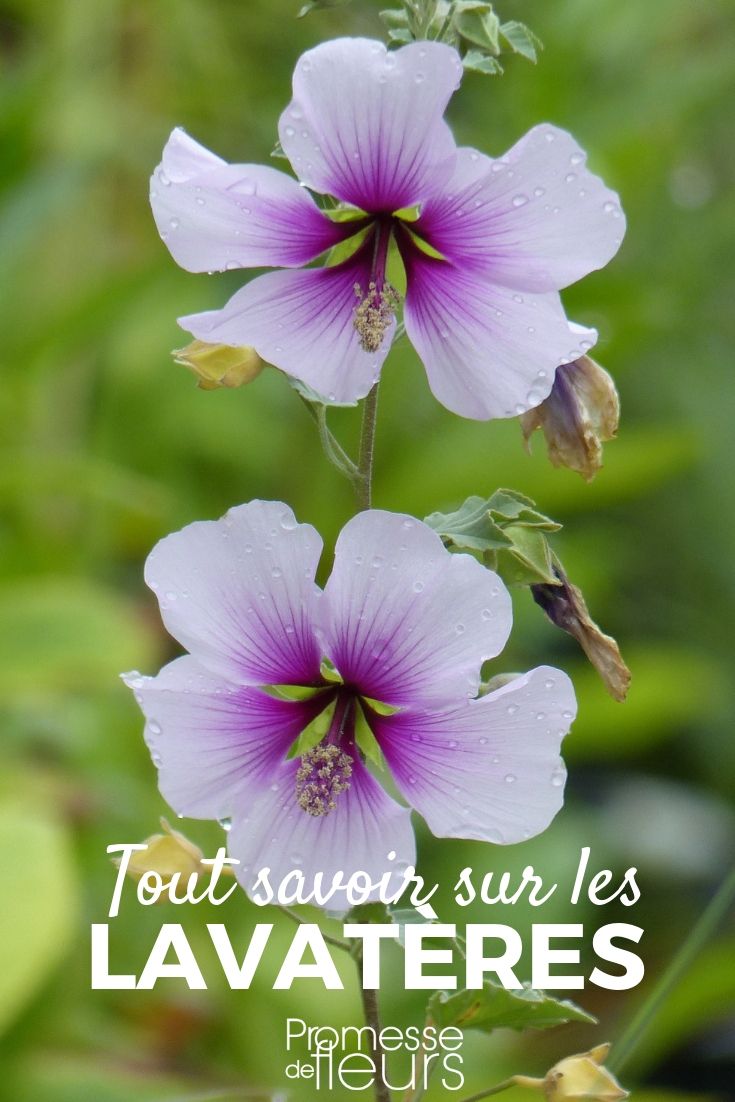


































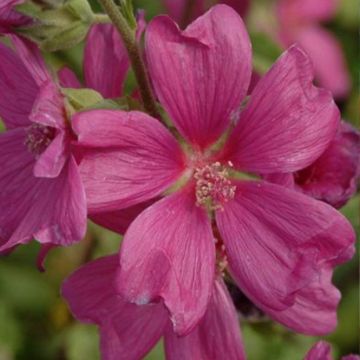

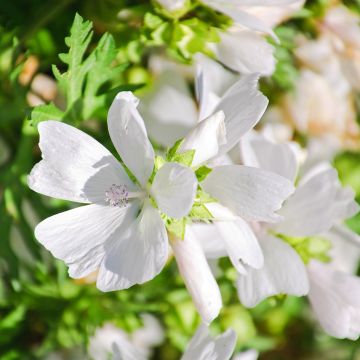

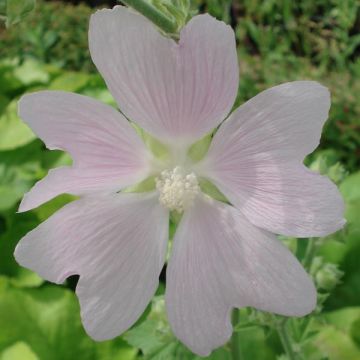
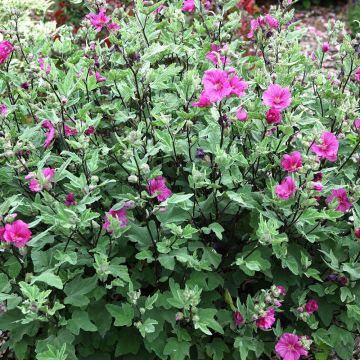
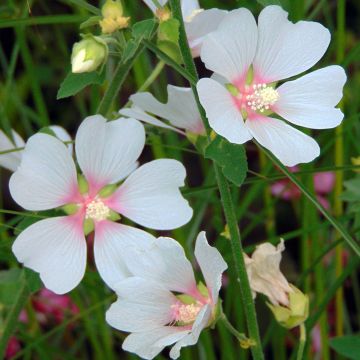
Comments